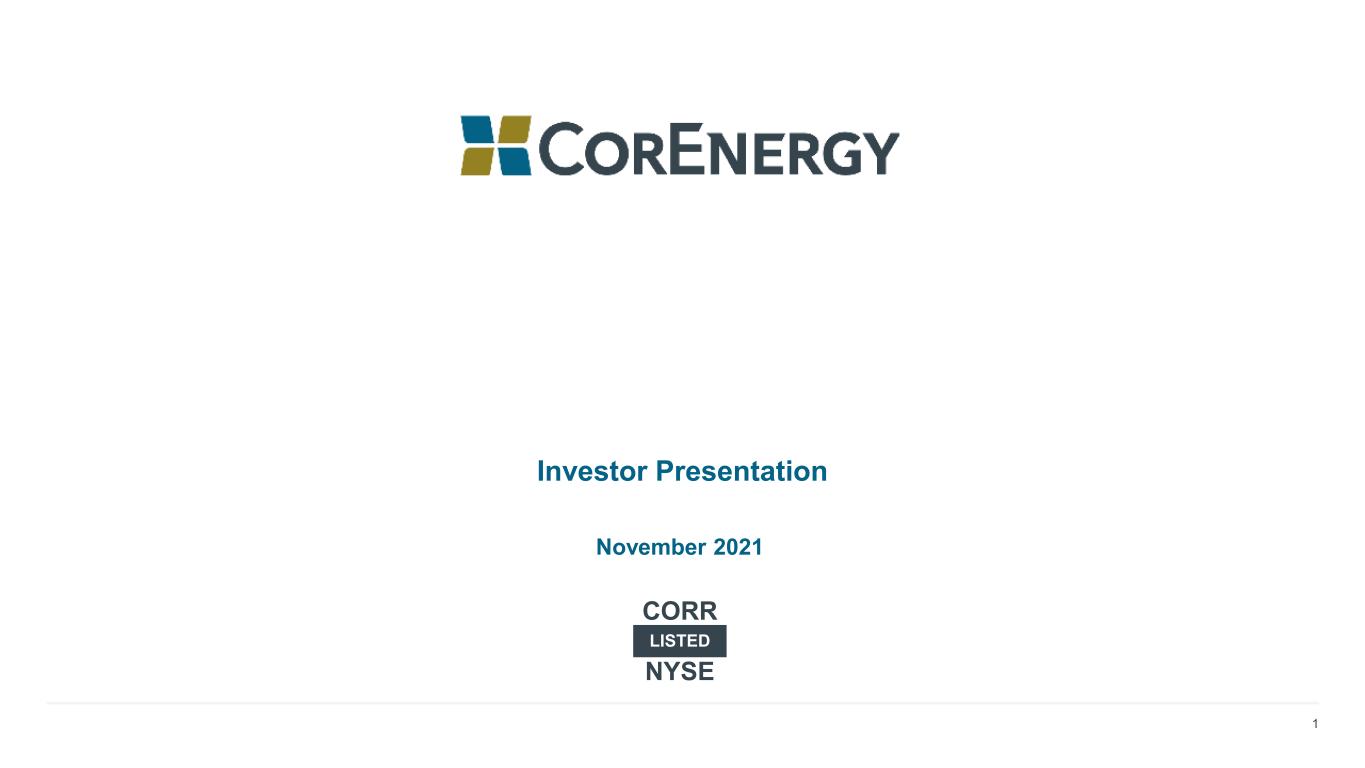
1 Investor Presentation LISTED CORR NYSE November 2021
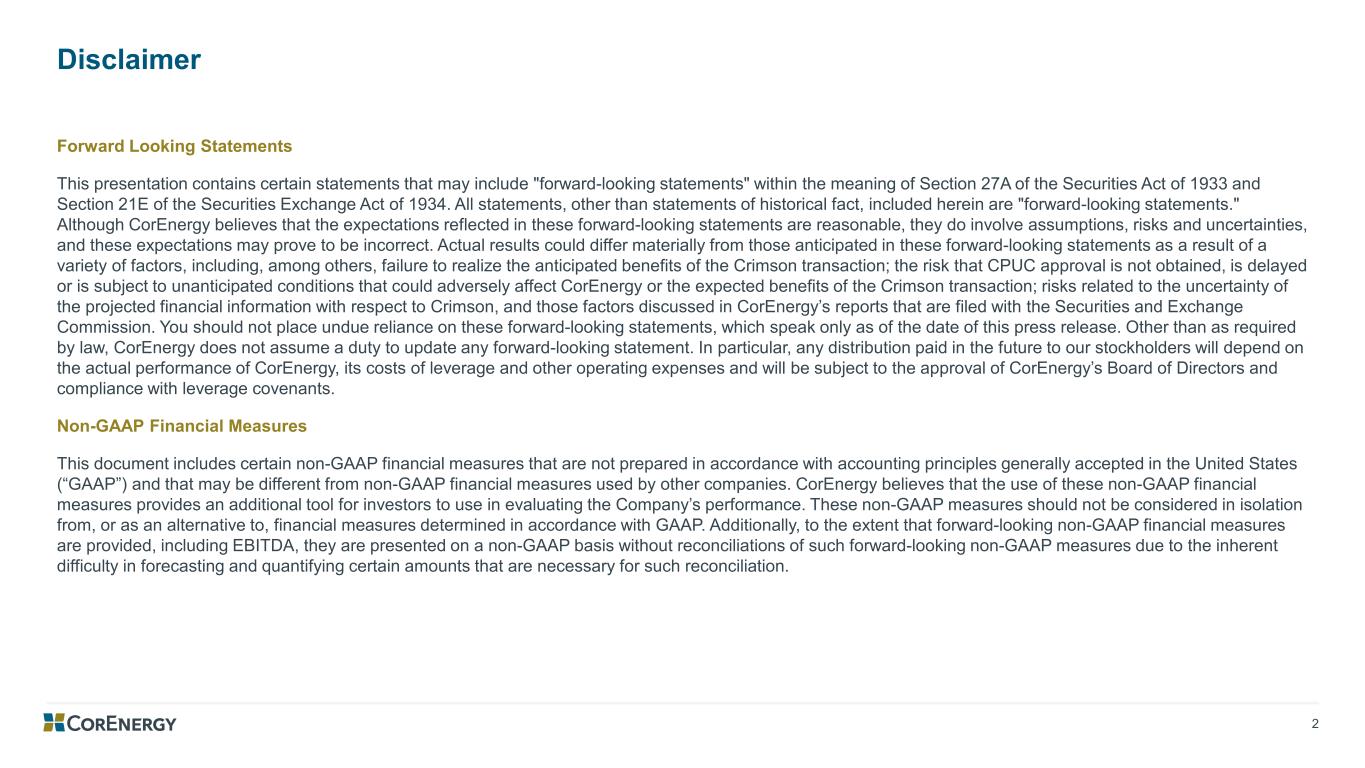
2 Disclaimer Forward Looking Statements This presentation contains certain statements that may include "forward-looking statements" within the meaning of Section 27A of the Securities Act of 1933 and Section 21E of the Securities Exchange Act of 1934. All statements, other than statements of historical fact, included herein are "forward-looking statements." Although CorEnergy believes that the expectations reflected in these forward-looking statements are reasonable, they do involve assumptions, risks and uncertainties, and these expectations may prove to be incorrect. Actual results could differ materially from those anticipated in these forward-looking statements as a result of a variety of factors, including, among others, failure to realize the anticipated benefits of the Crimson transaction; the risk that CPUC approval is not obtained, is delayed or is subject to unanticipated conditions that could adversely affect CorEnergy or the expected benefits of the Crimson transaction; risks related to the uncertainty of the projected financial information with respect to Crimson, and those factors discussed in CorEnergy’s reports that are filed with the Securities and Exchange Commission. You should not place undue reliance on these forward-looking statements, which speak only as of the date of this press release. Other than as required by law, CorEnergy does not assume a duty to update any forward-looking statement. In particular, any distribution paid in the future to our stockholders will depend on the actual performance of CorEnergy, its costs of leverage and other operating expenses and will be subject to the approval of CorEnergy’s Board of Directors and compliance with leverage covenants. Non-GAAP Financial Measures This document includes certain non-GAAP financial measures that are not prepared in accordance with accounting principles generally accepted in the United States (“GAAP”) and that may be different from non-GAAP financial measures used by other companies. CorEnergy believes that the use of these non-GAAP financial measures provides an additional tool for investors to use in evaluating the Company’s performance. These non-GAAP measures should not be considered in isolation from, or as an alternative to, financial measures determined in accordance with GAAP. Additionally, to the extent that forward-looking non-GAAP financial measures are provided, including EBITDA, they are presented on a non-GAAP basis without reconciliations of such forward-looking non-GAAP measures due to the inherent difficulty in forecasting and quantifying certain amounts that are necessary for such reconciliation.
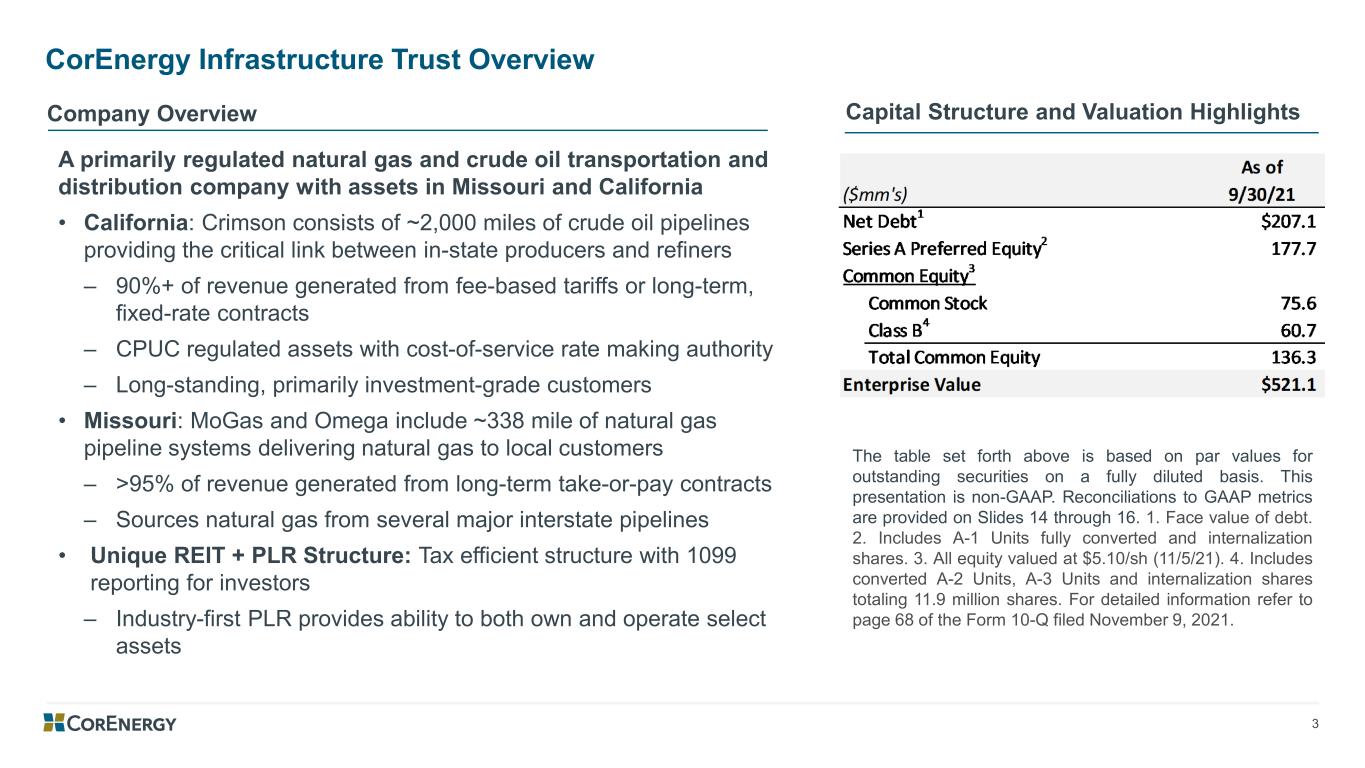
3 CorEnergy Infrastructure Trust Overview A primarily regulated natural gas and crude oil transportation and distribution company with assets in Missouri and California • California: Crimson consists of ~2,000 miles of crude oil pipelines providing the critical link between in-state producers and refiners ‒ 90%+ of revenue generated from fee-based tariffs or long-term, fixed-rate contracts ‒ CPUC regulated assets with cost-of-service rate making authority ‒ Long-standing, primarily investment-grade customers • Missouri: MoGas and Omega include ~338 mile of natural gas pipeline systems delivering natural gas to local customers ‒ >95% of revenue generated from long-term take-or-pay contracts ‒ Sources natural gas from several major interstate pipelines • Unique REIT + PLR Structure: Tax efficient structure with 1099 reporting for investors ‒ Industry-first PLR provides ability to both own and operate select assets Capital Structure and Valuation HighlightsCompany Overview The table set forth above is based on par values for outstanding securities on a fully diluted basis. This presentation is non-GAAP. Reconciliations to GAAP metrics are provided on Slides 14 through 16. 1. Face value of debt. 2. Includes A-1 Units fully converted and internalization shares. 3. All equity valued at $5.10/sh (11/5/21). 4. Includes converted A-2 Units, A-3 Units and internalization shares totaling 11.9 million shares. For detailed information refer to page 68 of the Form 10-Q filed November 9, 2021.
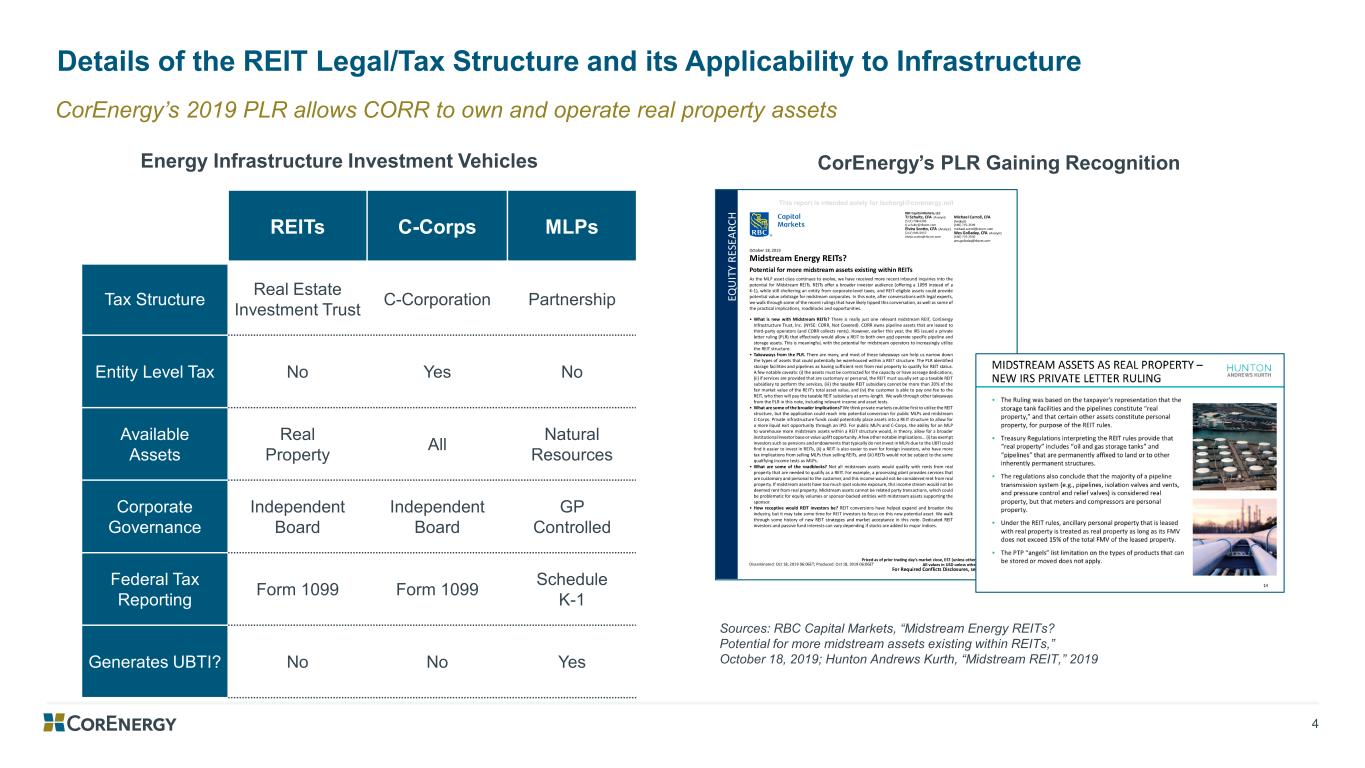
4 Details of the REIT Legal/Tax Structure and its Applicability to Infrastructure Sources: RBC Capital Markets, “Midstream Energy REITs? Potential for more midstream assets existing within REITs,” October 18, 2019; Hunton Andrews Kurth, “Midstream REIT,” 2019 REITs C-Corps MLPs Tax Structure Real Estate Investment Trust C-Corporation Partnership Entity Level Tax No Yes No Available Assets Real Property All Natural Resources Corporate Governance Independent Board Independent Board GP Controlled Federal Tax Reporting Form 1099 Form 1099 Schedule K-1 Generates UBTI? No No Yes Energy Infrastructure Investment Vehicles CorEnergy’s PLR Gaining Recognition CorEnergy’s 2019 PLR allows CORR to own and operate real property assets

5 1 2 3 • Eligible assets include pipelines, storage terminals, rights-of-way, offshore platforms, electric transmission/distribution lines • REITs offer superior domestic and foreign investor asset ownership tax efficiency relative to MLPs and C-corps • Having secured PLRs verifying asset qualification and operating capability, CORR is well positioned for asset consolidation Long-Term REIT Opportunities in the Energy Infrastructure Value Chain
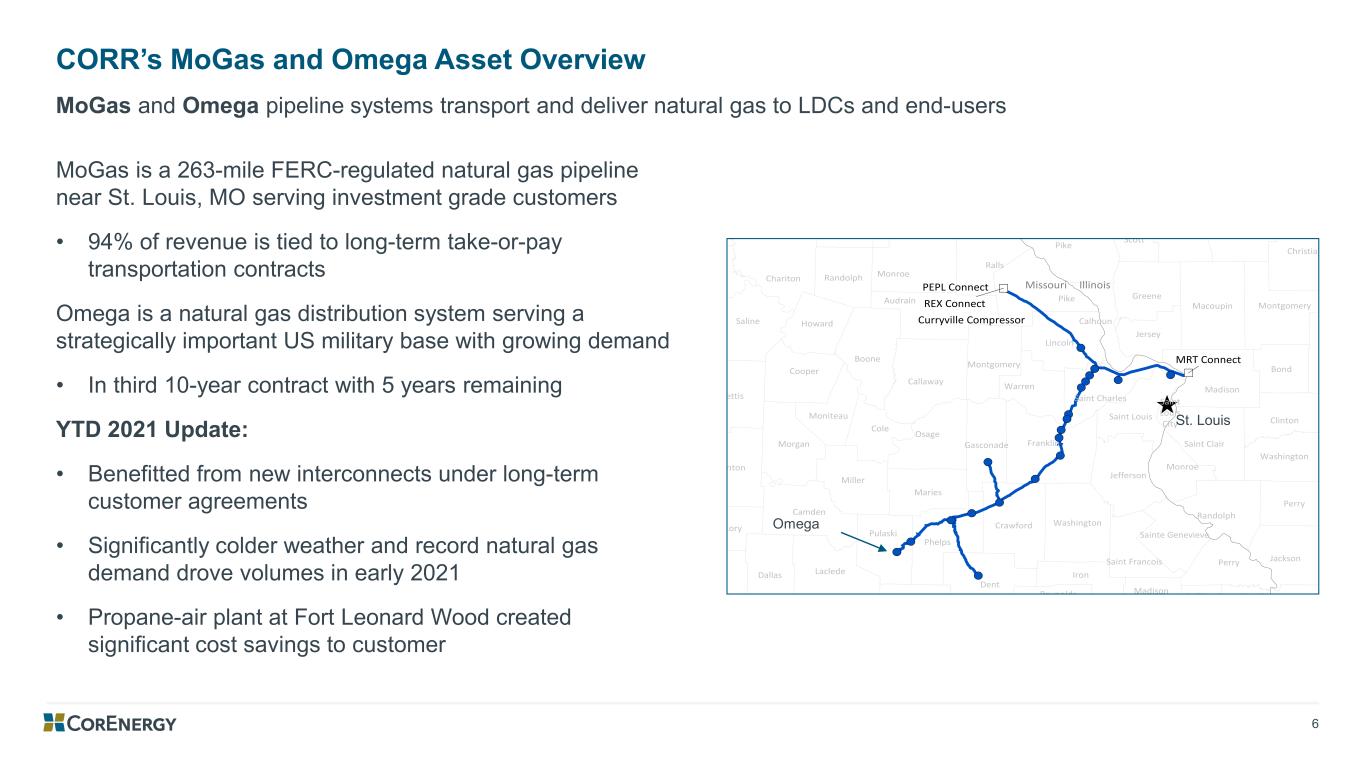
6 MoGas is a 263-mile FERC-regulated natural gas pipeline near St. Louis, MO serving investment grade customers • 94% of revenue is tied to long-term take-or-pay transportation contracts Omega is a natural gas distribution system serving a strategically important US military base with growing demand • In third 10-year contract with 5 years remaining YTD 2021 Update: • Benefitted from new interconnects under long-term customer agreements • Significantly colder weather and record natural gas demand drove volumes in early 2021 • Propane-air plant at Fort Leonard Wood created significant cost savings to customer MoGas and Omega pipeline systems transport and deliver natural gas to LDCs and end-users Pike Calhoun Lincoln Audrain Monroe Laclede Pulaski Madison Saint Louis City Saint Charles Saint Louis Chariton Moniteau Warren Franklin Phelps B lli C Gi dMadison Saint Francois Reynolds Iron IllinoisMissouri Curryville Compressor REX Connect PEPL Connect MRT Connect Bond Christia Clinton Greene Jackson Jersey Macoupin Monroe Montgomery Perry Pike Randolph Saint Clair Scott Washington nton Boone Callaway Camden Cole Cooper Crawford Dallas Dent Gasconade kory Howard Jefferson Maries Miller Montgomery Morgan Osage Perry ettis Ralls Randolph Sainte Genevieve Saline Washington St. Louis Omega CORR’s MoGas and Omega Asset Overview
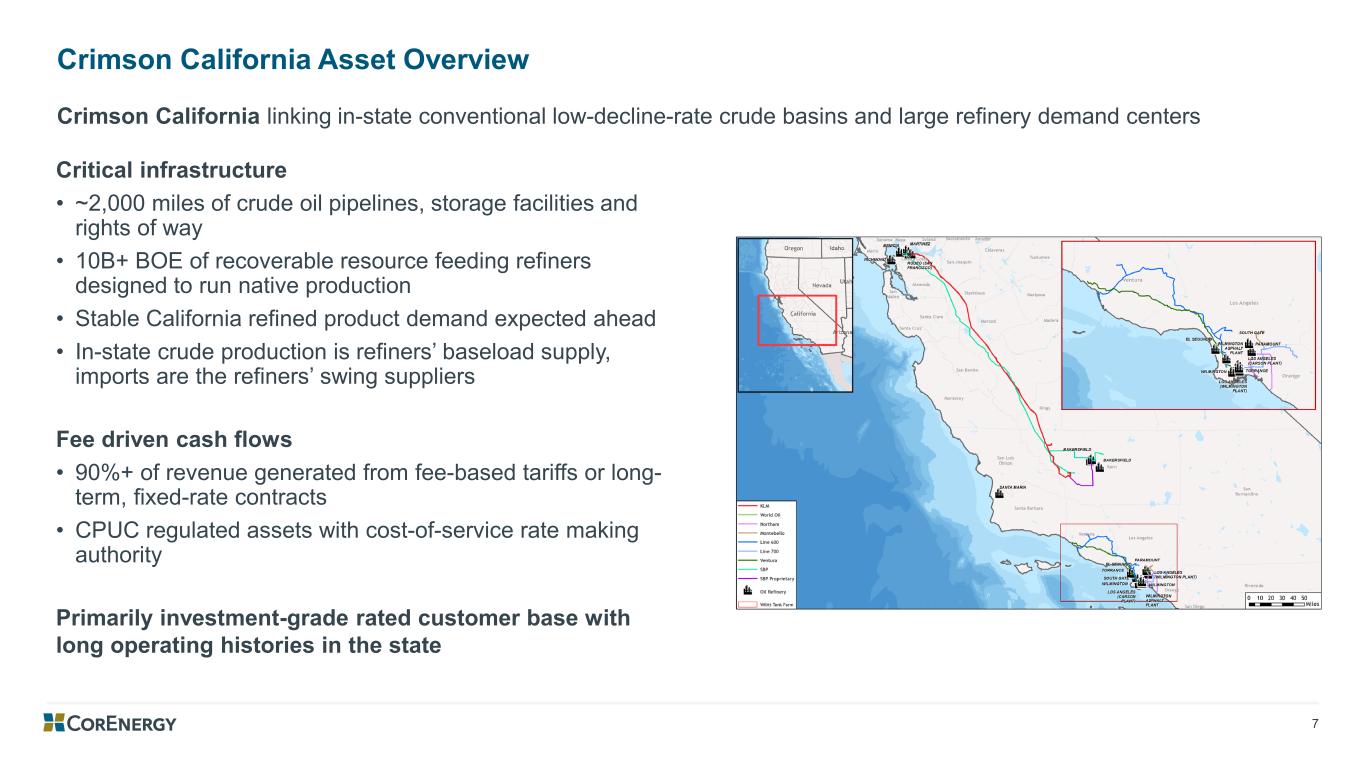
7 Crimson California linking in-state conventional low-decline-rate crude basins and large refinery demand centers Critical infrastructure • ~2,000 miles of crude oil pipelines, storage facilities and rights of way • 10B+ BOE of recoverable resource feeding refiners designed to run native production • Stable California refined product demand expected ahead • In-state crude production is refiners’ baseload supply, imports are the refiners’ swing suppliers Fee driven cash flows • 90%+ of revenue generated from fee-based tariffs or long- term, fixed-rate contracts • CPUC regulated assets with cost-of-service rate making authority Primarily investment-grade rated customer base with long operating histories in the state Crimson California Asset Overview
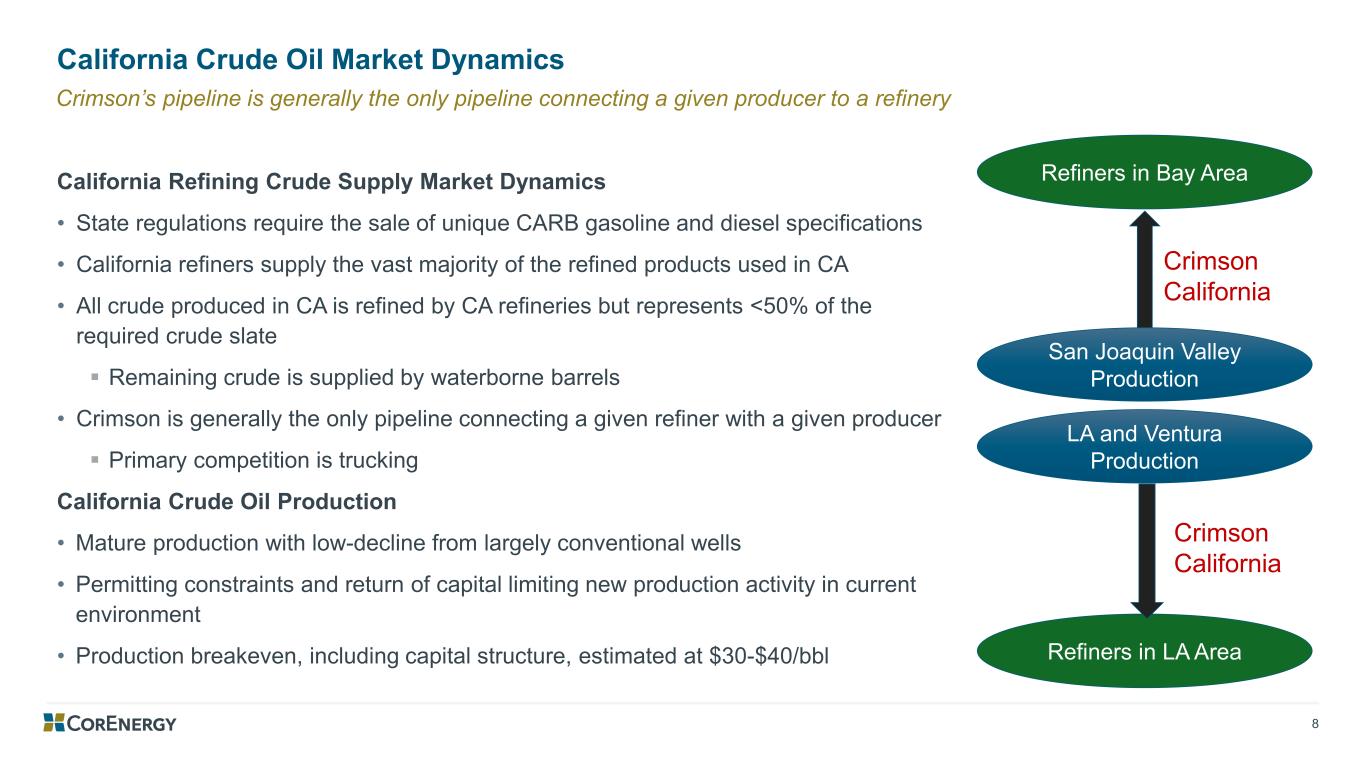
8 California Refining Crude Supply Market Dynamics • State regulations require the sale of unique CARB gasoline and diesel specifications • California refiners supply the vast majority of the refined products used in CA • All crude produced in CA is refined by CA refineries but represents <50% of the required crude slate Remaining crude is supplied by waterborne barrels • Crimson is generally the only pipeline connecting a given refiner with a given producer Primary competition is trucking California Crude Oil Production • Mature production with low-decline from largely conventional wells • Permitting constraints and return of capital limiting new production activity in current environment • Production breakeven, including capital structure, estimated at $30-$40/bbl Crimson’s pipeline is generally the only pipeline connecting a given producer to a refinery California Crude Oil Market Dynamics San Joaquin Valley Production LA and Ventura Production Refiners in LA Area Refiners in Bay Area Crimson California Crimson California

9 Expansion within our existing pipeline footprint • High barriers to entry in most of the areas we operate • Unique operational and regulatory expertise given the area we operate in • Difficult to replicate rights-of-ways in CA connecting key regions available for digital infrastructure Corporate level acquisitions that add scale and diversification • The REIT structure combines the best aspects of both the C-Corp and MLP structure • Much larger pool of capital from which to draw compared to MLPs Participate in the energy transition through the storage and transportation of renewable energy sources • Crimson owns 2,000 miles of pipeline, which could be utilized for alternative uses like carbon sequestration, renewable diesel, etc • Many infrastructure assets needed for energy transition are REIT qualifying CorEnergy’s 3-Part Growth Strategy
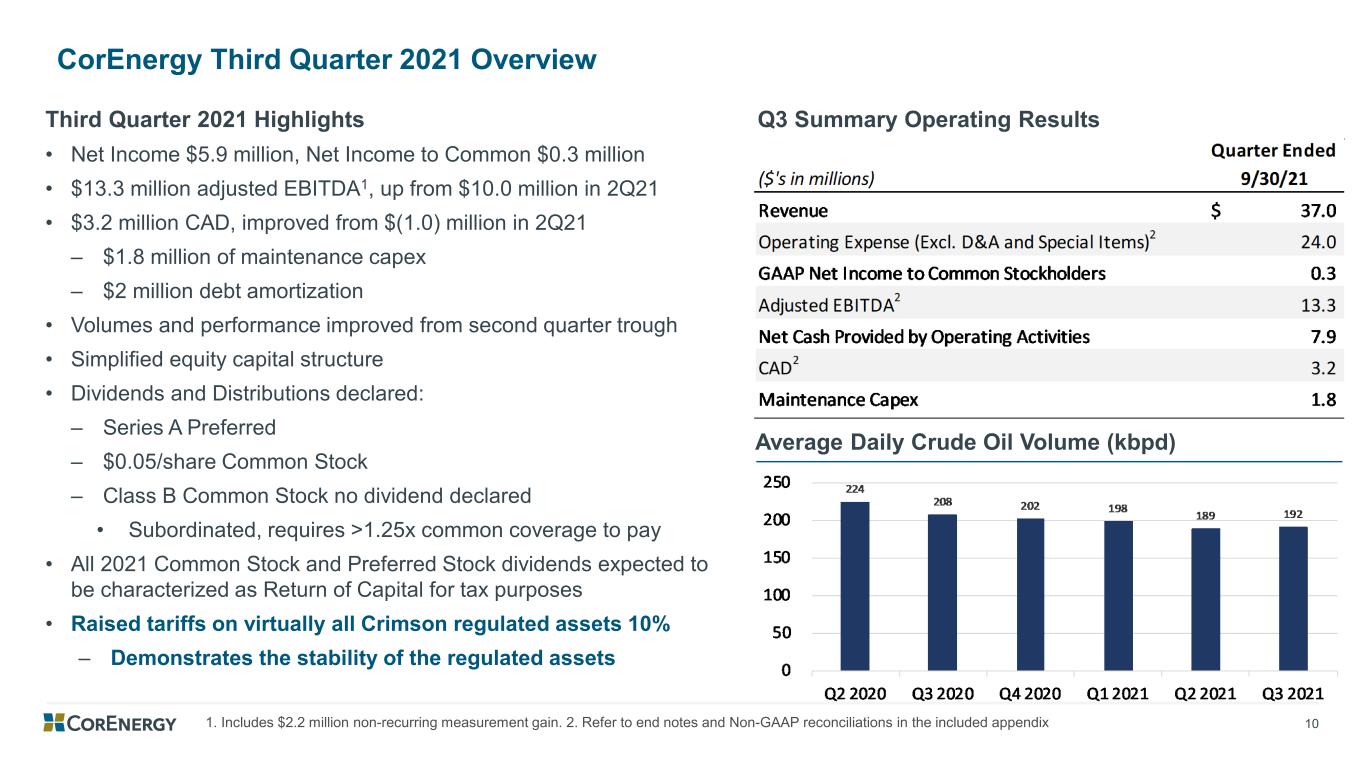
10 CorEnergy Third Quarter 2021 Overview 1. Includes $2.2 million non-recurring measurement gain. 2. Refer to end notes and Non-GAAP reconciliations in the included appendix Third Quarter 2021 Highlights • Net Income $5.9 million, Net Income to Common $0.3 million • $13.3 million adjusted EBITDA1, up from $10.0 million in 2Q21 • $3.2 million CAD, improved from $(1.0) million in 2Q21 ‒ $1.8 million of maintenance capex ‒ $2 million debt amortization • Volumes and performance improved from second quarter trough • Simplified equity capital structure • Dividends and Distributions declared: ‒ Series A Preferred ‒ $0.05/share Common Stock ‒ Class B Common Stock no dividend declared • Subordinated, requires >1.25x common coverage to pay • All 2021 Common Stock and Preferred Stock dividends expected to be characterized as Return of Capital for tax purposes • Raised tariffs on virtually all Crimson regulated assets 10% ‒ Demonstrates the stability of the regulated assets Q3 Summary Operating Results Average Daily Crude Oil Volume (kbpd)
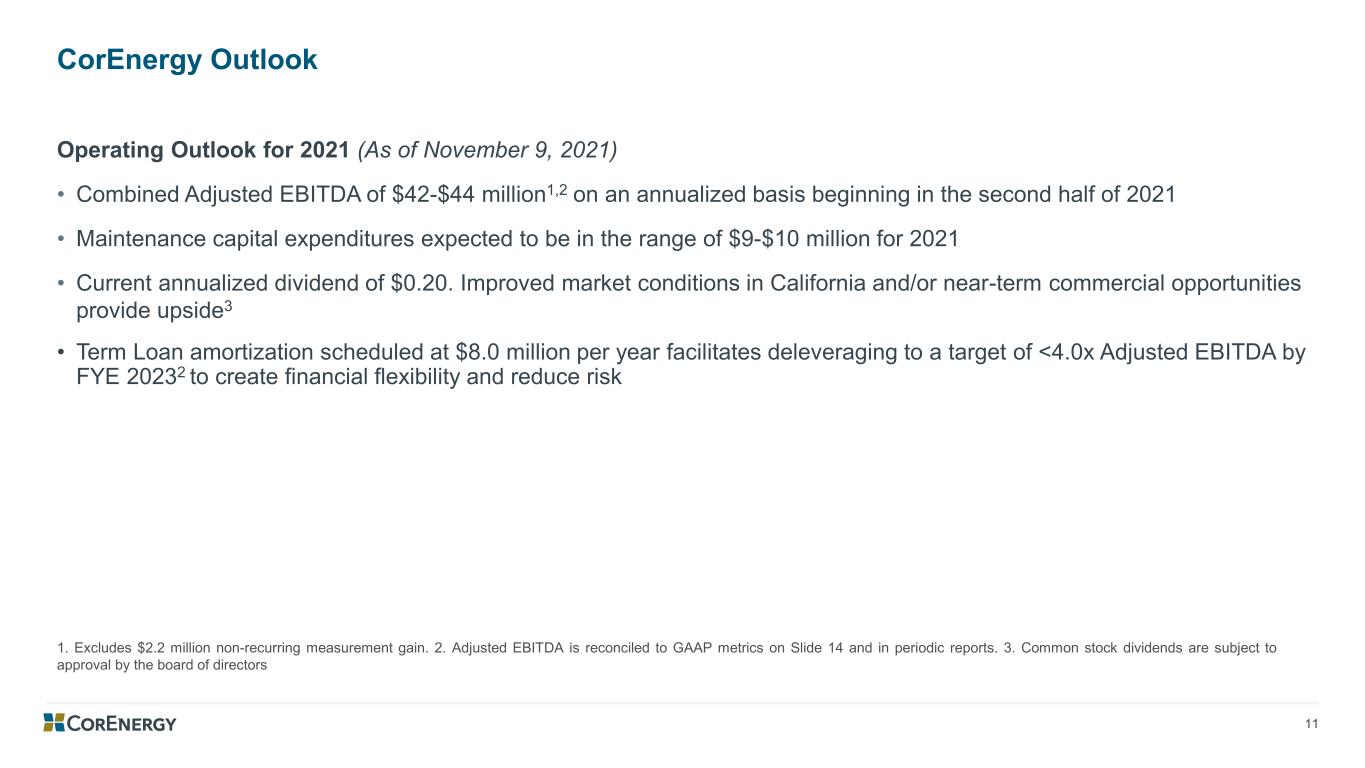
11 Operating Outlook for 2021 (As of November 9, 2021) • Combined Adjusted EBITDA of $42-$44 million1,2 on an annualized basis beginning in the second half of 2021 • Maintenance capital expenditures expected to be in the range of $9-$10 million for 2021 • Current annualized dividend of $0.20. Improved market conditions in California and/or near-term commercial opportunities provide upside3 • Term Loan amortization scheduled at $8.0 million per year facilitates deleveraging to a target of <4.0x Adjusted EBITDA by FYE 20232 to create financial flexibility and reduce risk CorEnergy Outlook 1. Excludes $2.2 million non-recurring measurement gain. 2. Adjusted EBITDA is reconciled to GAAP metrics on Slide 14 and in periodic reports. 3. Common stock dividends are subject to approval by the board of directors
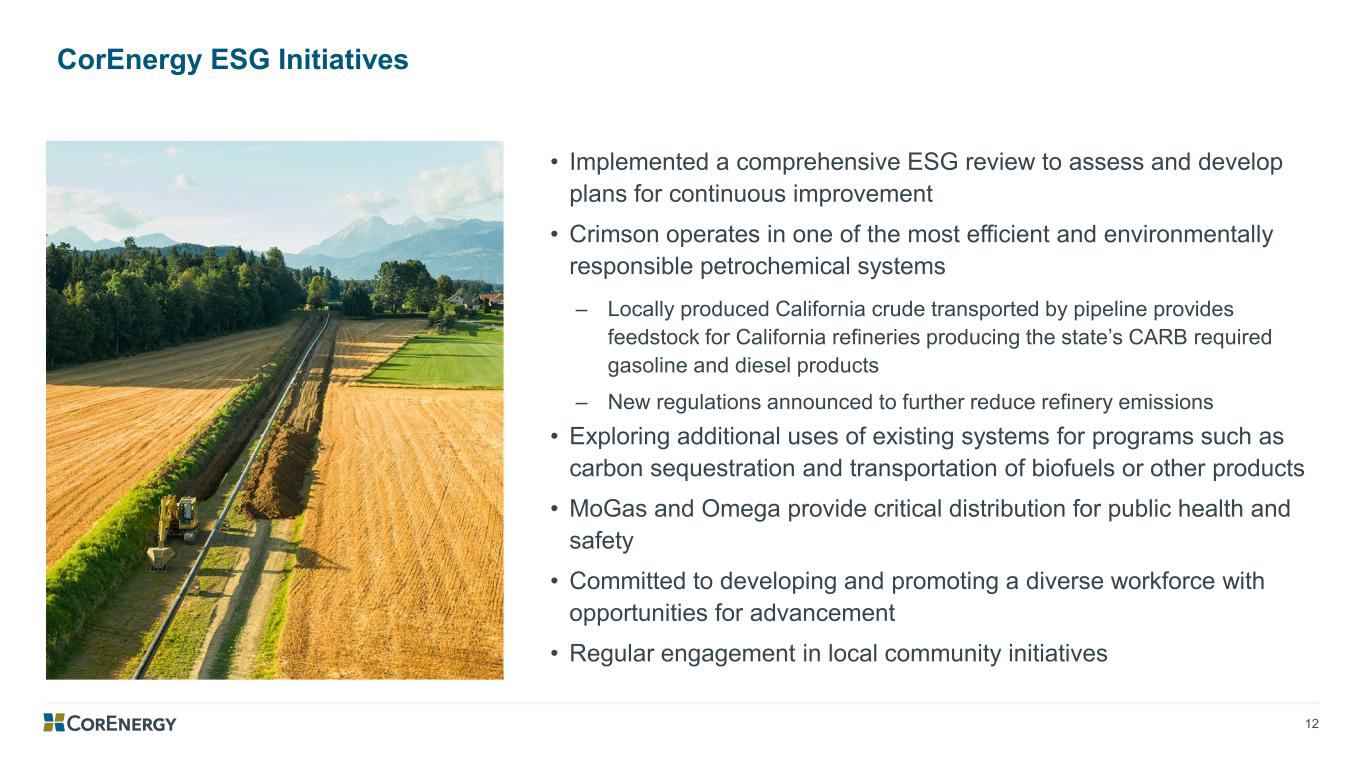
12 CorEnergy ESG Initiatives • Implemented a comprehensive ESG review to assess and develop plans for continuous improvement • Crimson operates in one of the most efficient and environmentally responsible petrochemical systems ‒ Locally produced California crude transported by pipeline provides feedstock for California refineries producing the state’s CARB required gasoline and diesel products ‒ New regulations announced to further reduce refinery emissions • Exploring additional uses of existing systems for programs such as carbon sequestration and transportation of biofuels or other products • MoGas and Omega provide critical distribution for public health and safety • Committed to developing and promoting a diverse workforce with opportunities for advancement • Regular engagement in local community initiatives
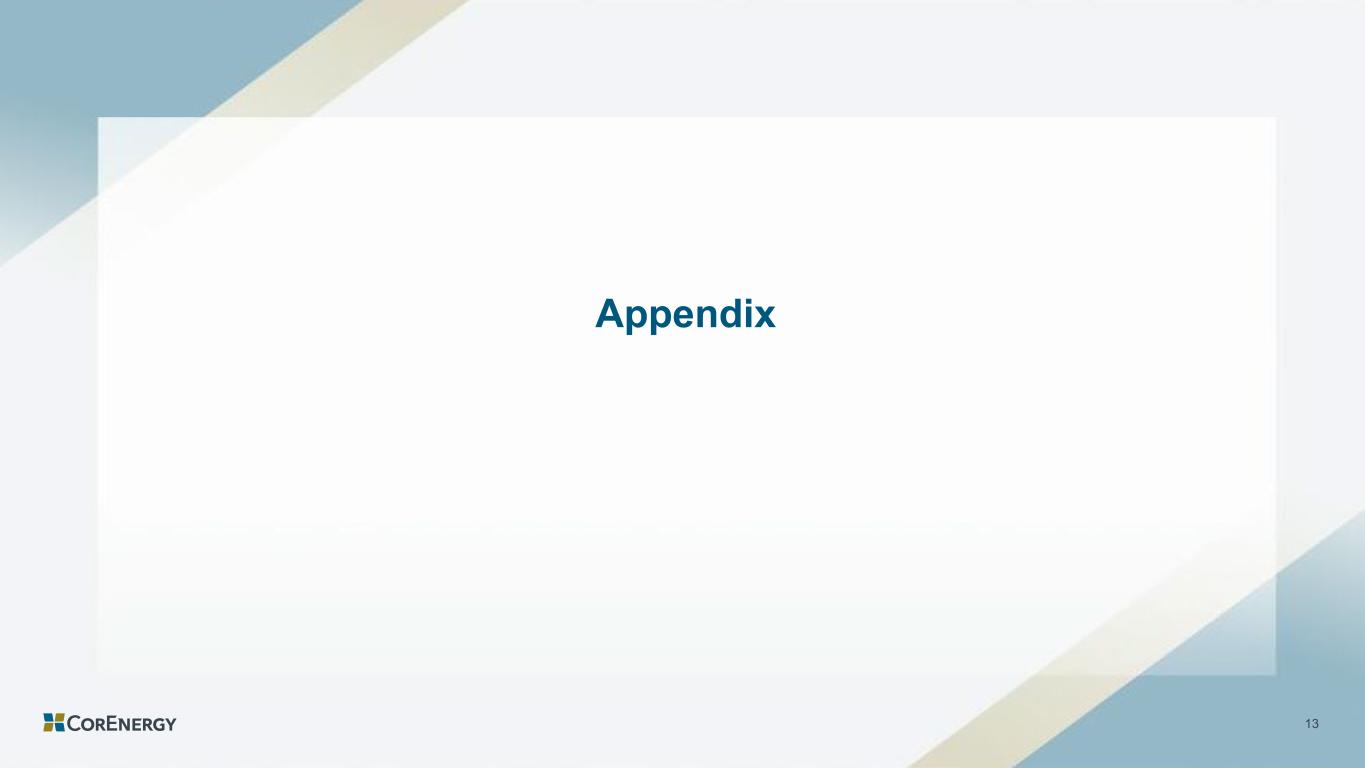
13 Appendix
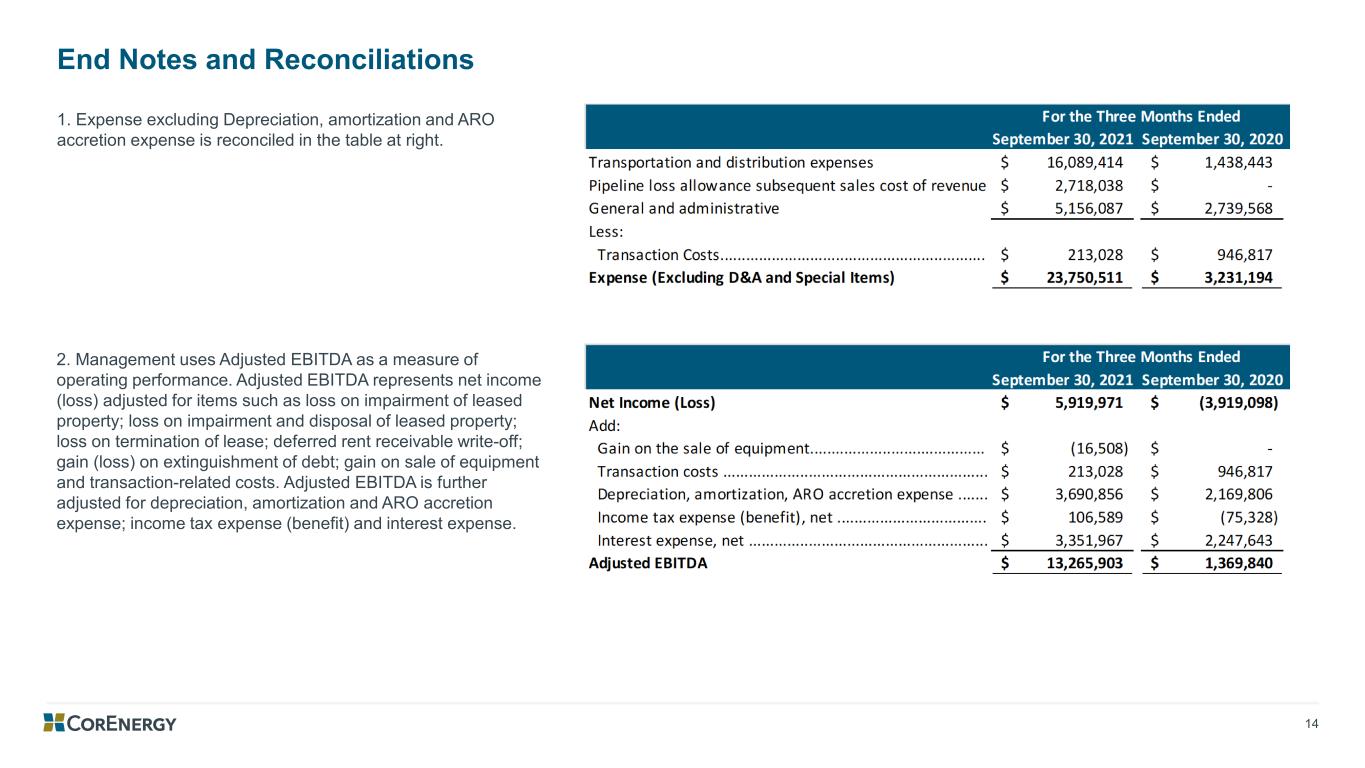
14 End Notes and Reconciliations 1. Expense excluding Depreciation, amortization and ARO accretion expense is reconciled in the table at right. 2. Management uses Adjusted EBITDA as a measure of operating performance. Adjusted EBITDA represents net income (loss) adjusted for items such as loss on impairment of leased property; loss on impairment and disposal of leased property; loss on termination of lease; deferred rent receivable write-off; gain (loss) on extinguishment of debt; gain on sale of equipment and transaction-related costs. Adjusted EBITDA is further adjusted for depreciation, amortization and ARO accretion expense; income tax expense (benefit) and interest expense.
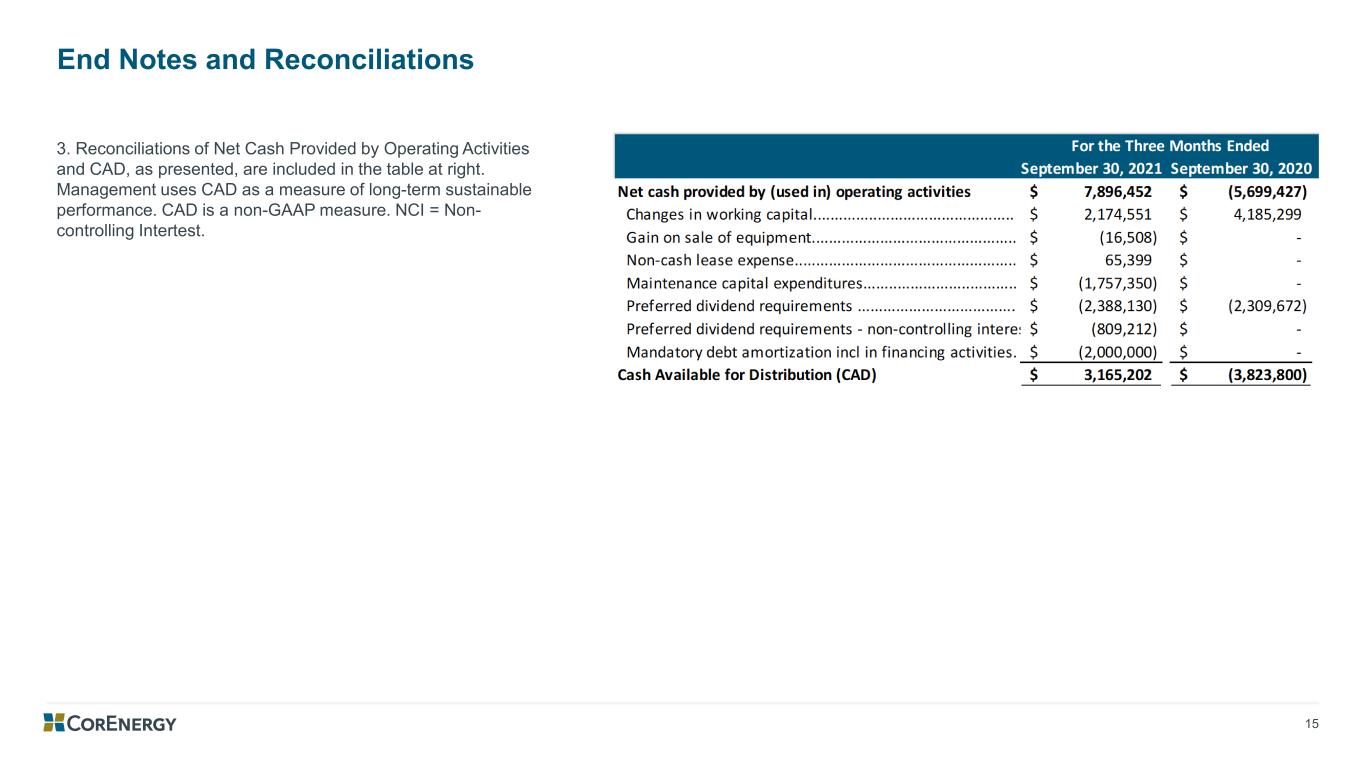
15 End Notes and Reconciliations 3. Reconciliations of Net Cash Provided by Operating Activities and CAD, as presented, are included in the table at right. Management uses CAD as a measure of long-term sustainable performance. CAD is a non-GAAP measure. NCI = Non- controlling Intertest.
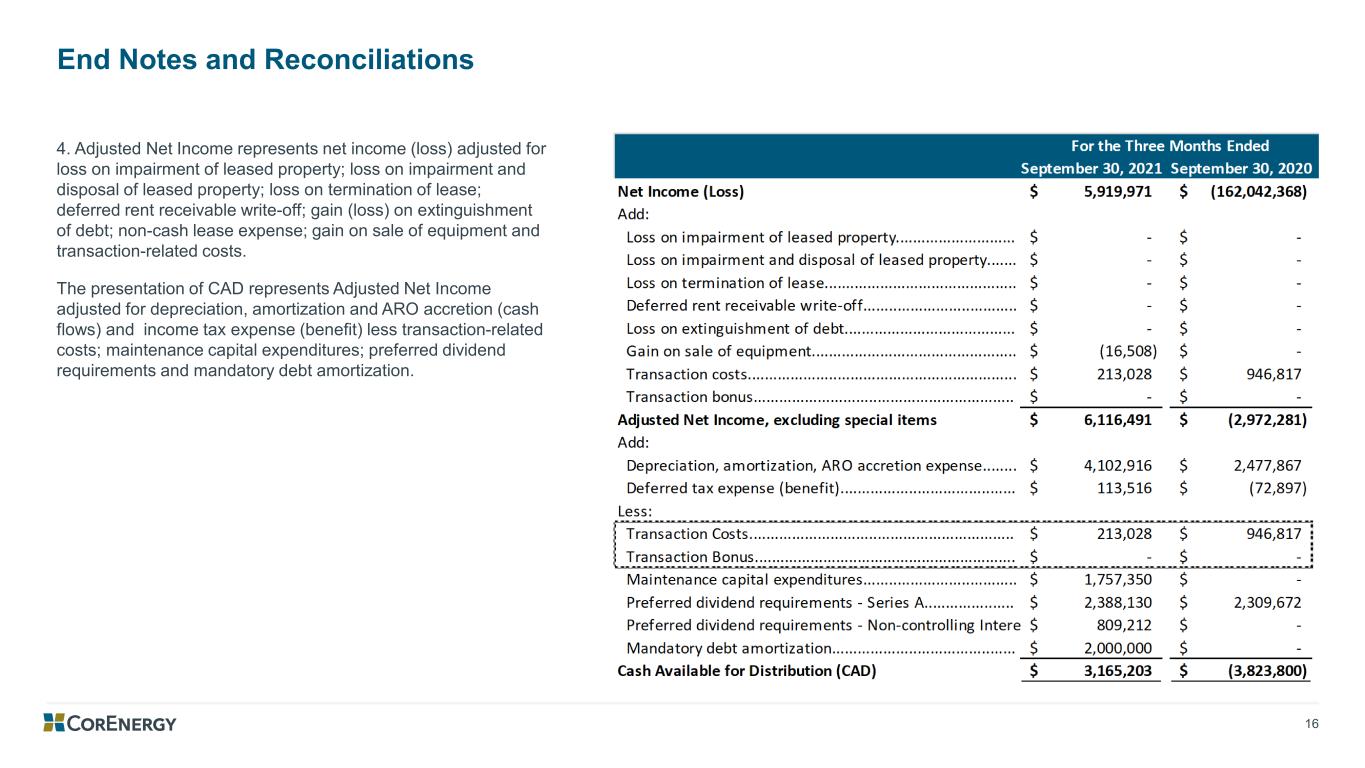
16 End Notes and Reconciliations 4. Adjusted Net Income represents net income (loss) adjusted for loss on impairment of leased property; loss on impairment and disposal of leased property; loss on termination of lease; deferred rent receivable write-off; gain (loss) on extinguishment of debt; non-cash lease expense; gain on sale of equipment and transaction-related costs. The presentation of CAD represents Adjusted Net Income adjusted for depreciation, amortization and ARO accretion (cash flows) and income tax expense (benefit) less transaction-related costs; maintenance capital expenditures; preferred dividend requirements and mandatory debt amortization.
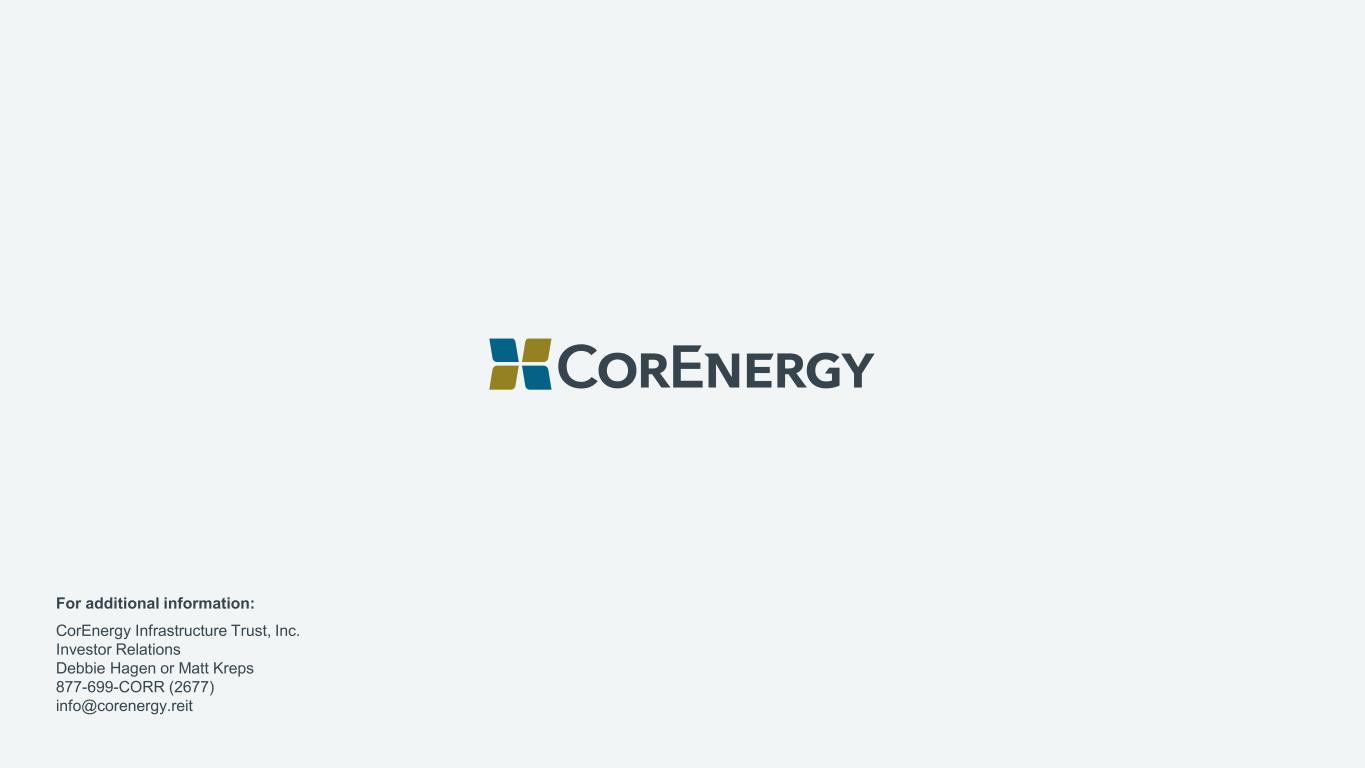
17 For additional information: CorEnergy Infrastructure Trust, Inc. Investor Relations Debbie Hagen or Matt Kreps 877-699-CORR (2677) info@corenergy.reit